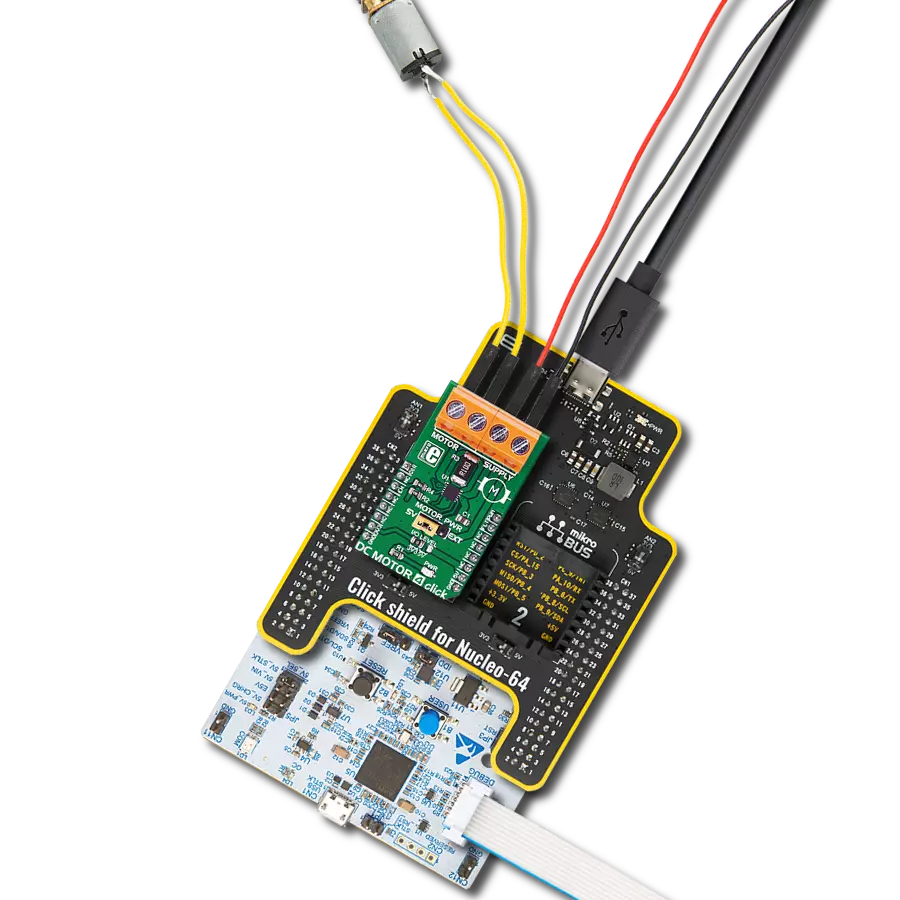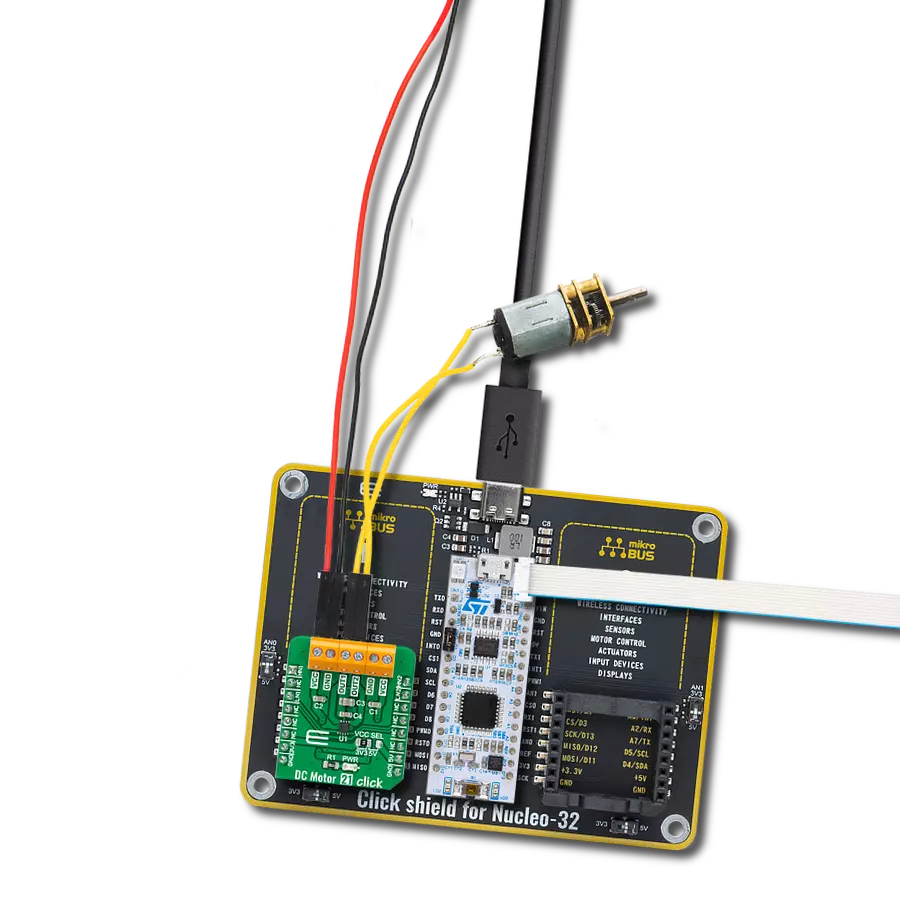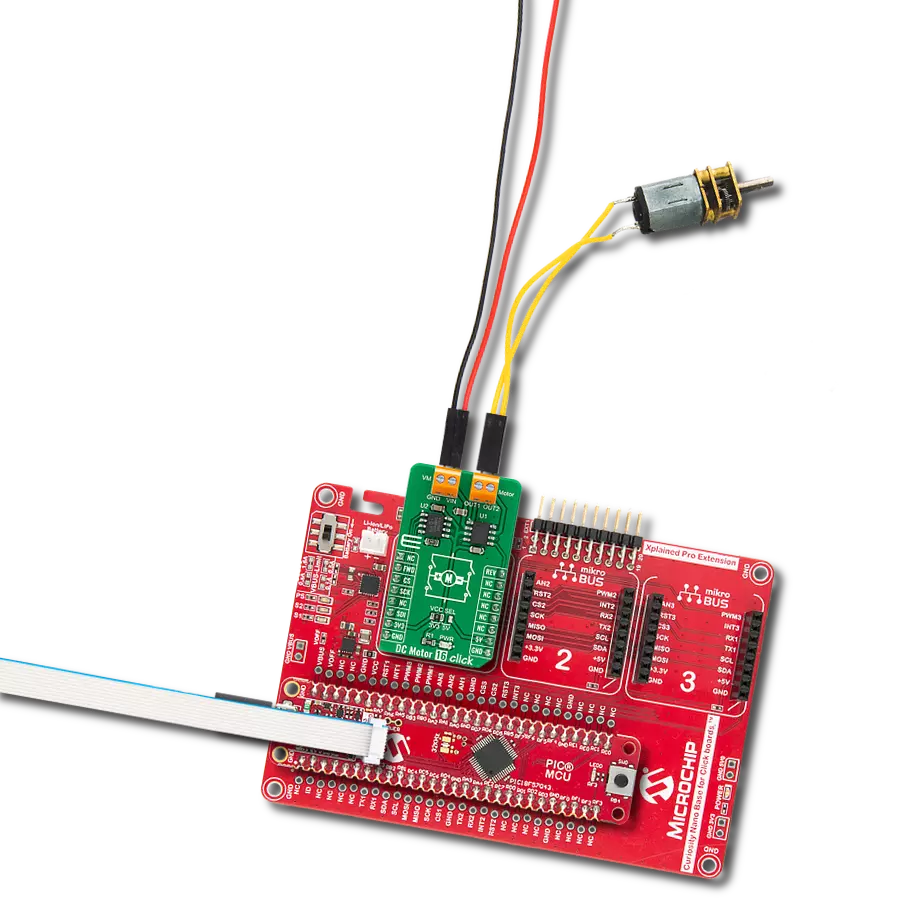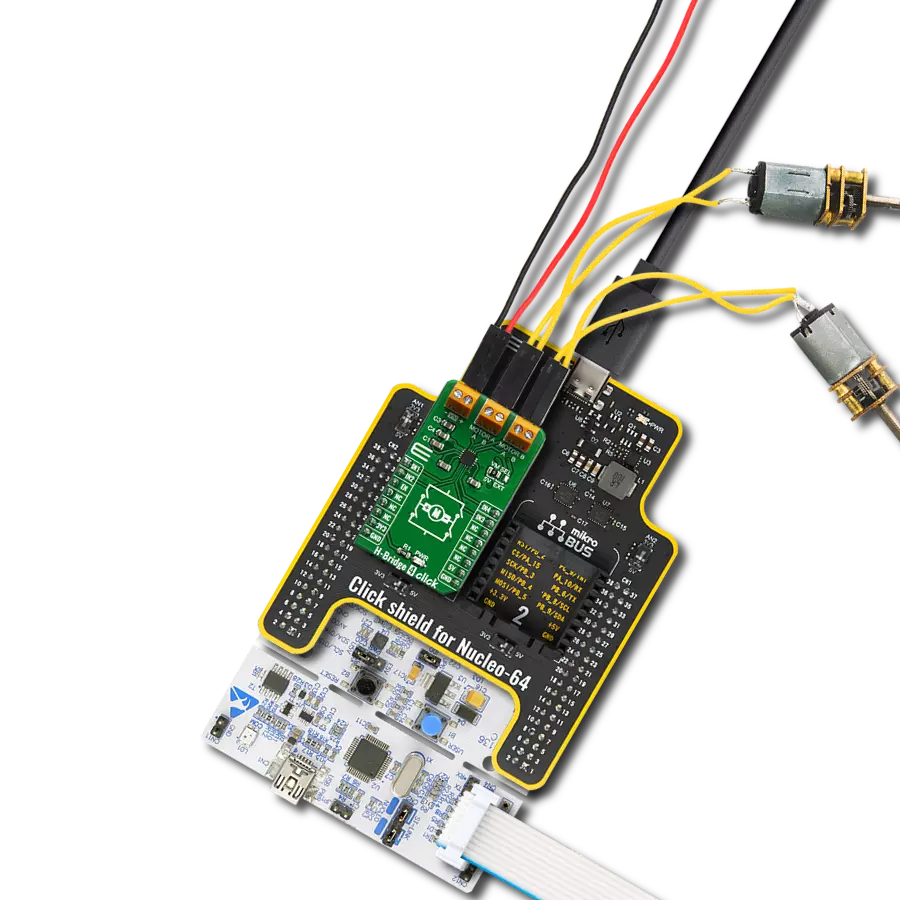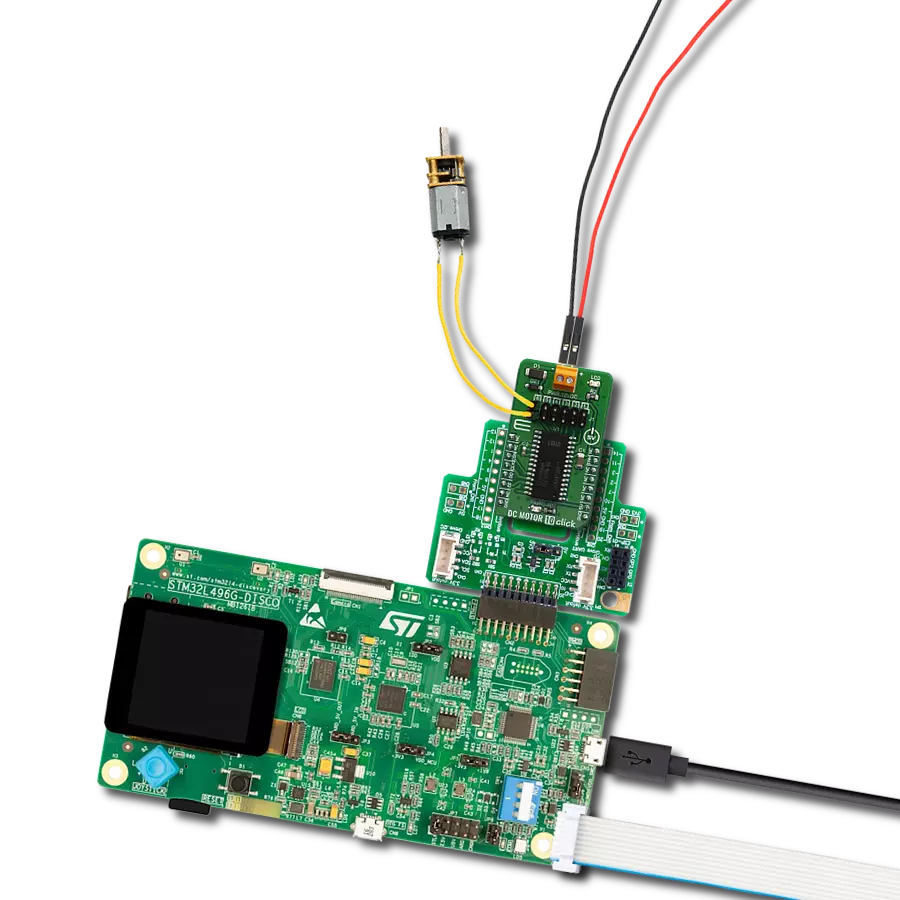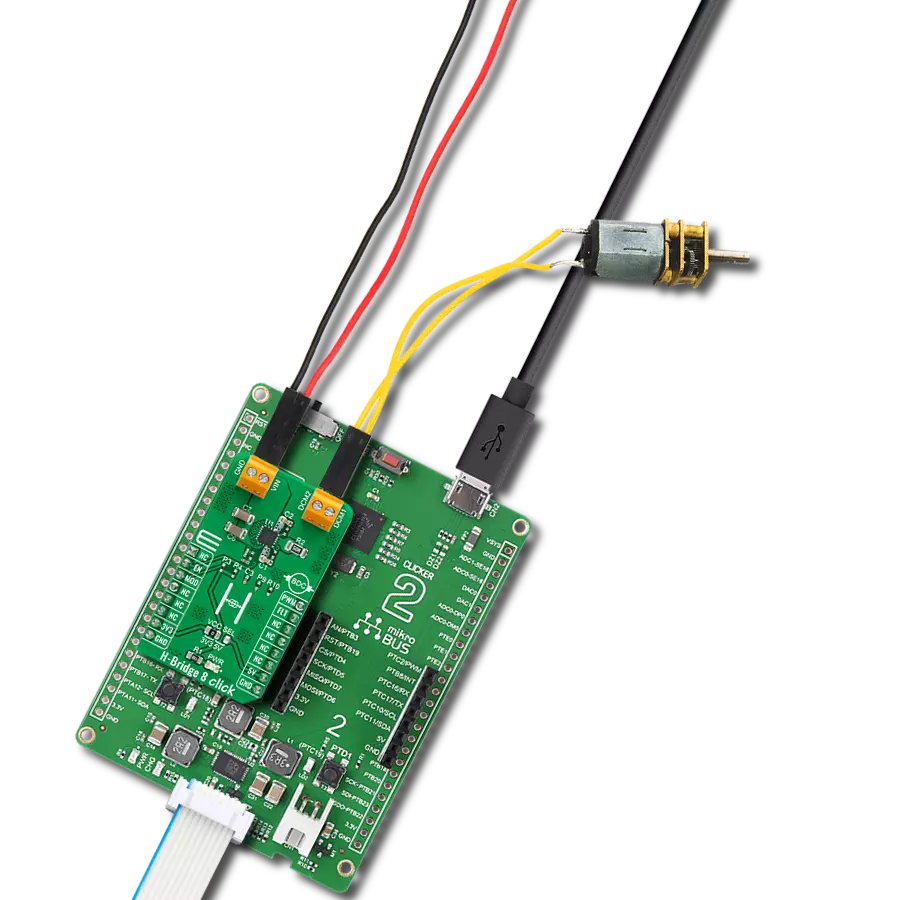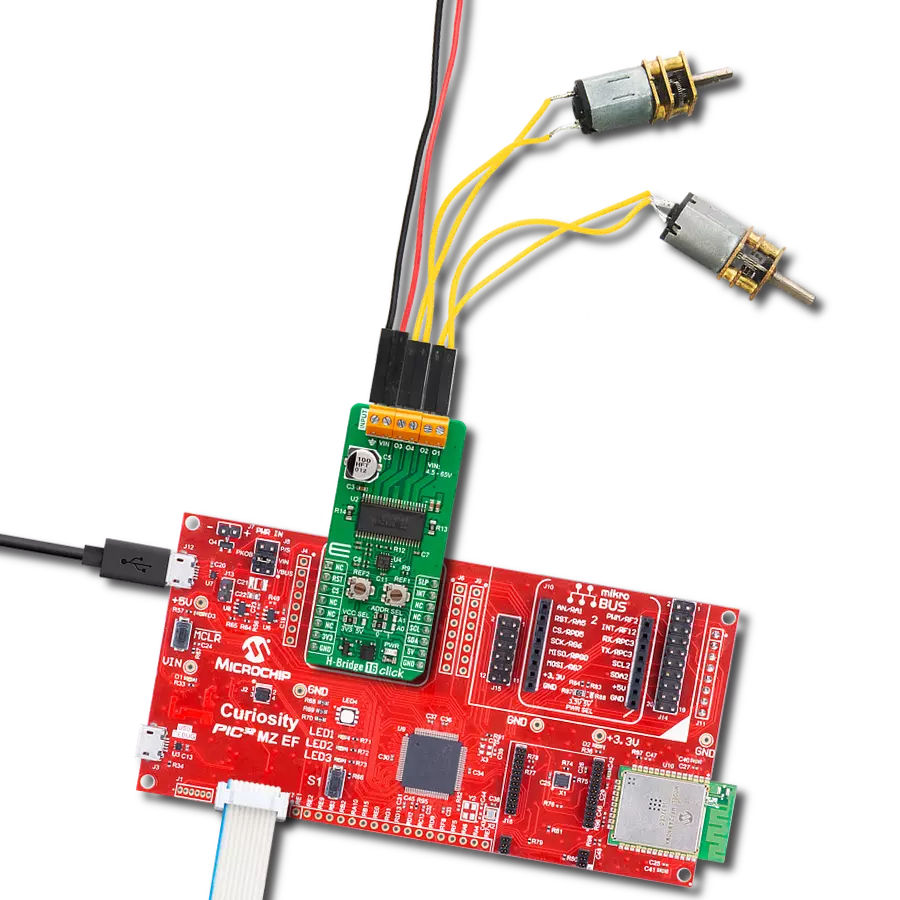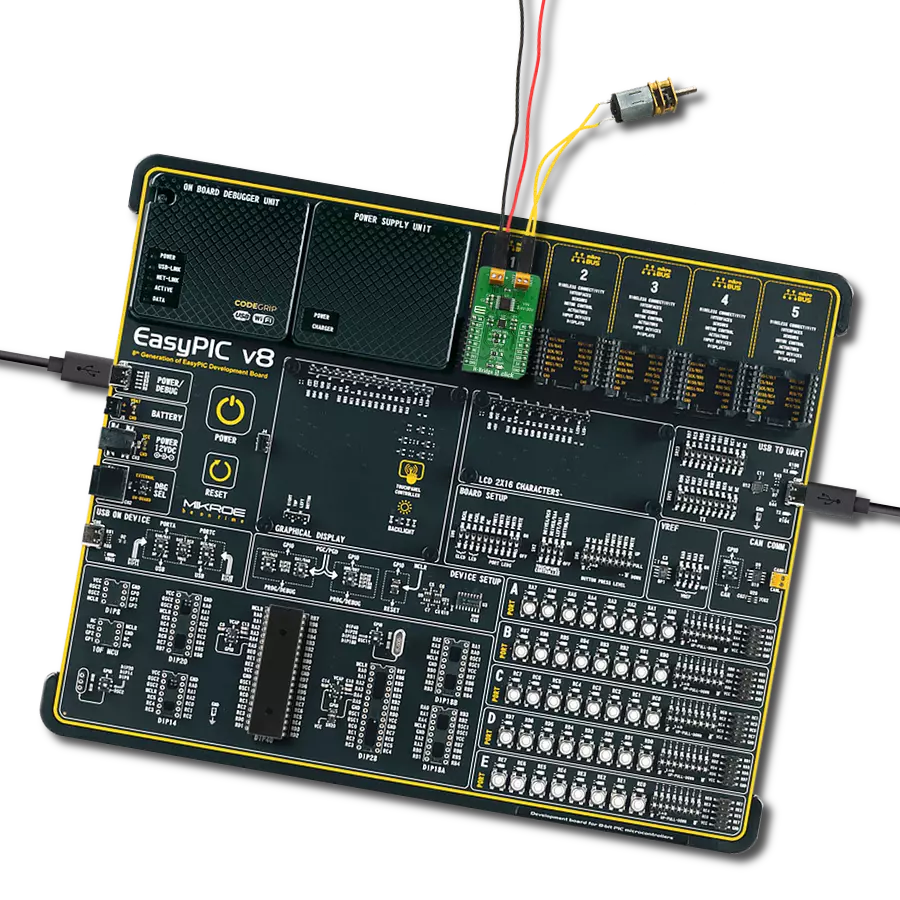Embrace brushed motor control. Control motor current limiting and current sensing using this DC motor control solution!
A
A
Hardware Overview
How does it work?
DC Motor 11 Click is based on the DRV8830, a low-voltage motor driver with a serial interface from Texas Instruments. This IC is an integrated H-Bridge driver with a current regulation circuit limiting the current through the connected load with a single resistor. A low ON resistance through the H-Bridge reduces the overall power dissipation, while an advanced control circuit injects dead-time intervals whenever the outputs change their state, preventing current shoot-throughs. The DRV8830 also integrates protection features, including undervoltage, overcurrent, and overtemperature protection. Each of these events will cause the H-Bridge MOSFETs to be disabled. After removing a fault condition, the device will continue its operation. The DRV8830 includes an internal reference voltage that is connected to a DAC. This DAC generates
a voltage that is used to set the PWM-regulated output voltage and, therefore, the speed and direction of the motor rotation. The DAC is controlled by the VSET bits from the I2C interface. For detailed commands for desired output voltages, refer to the DRV8830 datasheet. DC Motor 11 click uses the I2C interface to communicate with the main MCU and the fault pin (FLT), which is routed to the INT pin of the mikroBUS™ socket. The I2C address can be selected using additional SMD jumpers (JP1 and JP2) labeled ADDR SEL, determining the least significant bits of the DRV8830 slave I2C address. Although the DRV8830 supports up to 1A Maximum DC/RMS or Peak Drive Current Current through the connected load, it is limited to a maximum of 0.6A. A higher current will cause the overcurrent protection to be activated.
The peak current through the motor is limited to about 1A, ensuring reliable spin-up while preventing the overcurrent protection from being activated, even if a large load torque is applied. Although there is a low resistance across the H-Bridge, the current should be monitored to prevent excessive heating in situations where the load is reasonably high. This Click board™ can only be operated with a 3.3V logic voltage level. The board must perform appropriate logic voltage level conversion before using MCUs with different logic levels. However, the Click board™ comes equipped with a library containing functions and an example code that can be used as a reference for further development.
Features overview
Development board
Arduino UNO is a versatile microcontroller board built around the ATmega328P chip. It offers extensive connectivity options for various projects, featuring 14 digital input/output pins, six of which are PWM-capable, along with six analog inputs. Its core components include a 16MHz ceramic resonator, a USB connection, a power jack, an
ICSP header, and a reset button, providing everything necessary to power and program the board. The Uno is ready to go, whether connected to a computer via USB or powered by an AC-to-DC adapter or battery. As the first USB Arduino board, it serves as the benchmark for the Arduino platform, with "Uno" symbolizing its status as the
first in a series. This name choice, meaning "one" in Italian, commemorates the launch of Arduino Software (IDE) 1.0. Initially introduced alongside version 1.0 of the Arduino Software (IDE), the Uno has since become the foundational model for subsequent Arduino releases, embodying the platform's evolution.
Microcontroller Overview
MCU Card / MCU
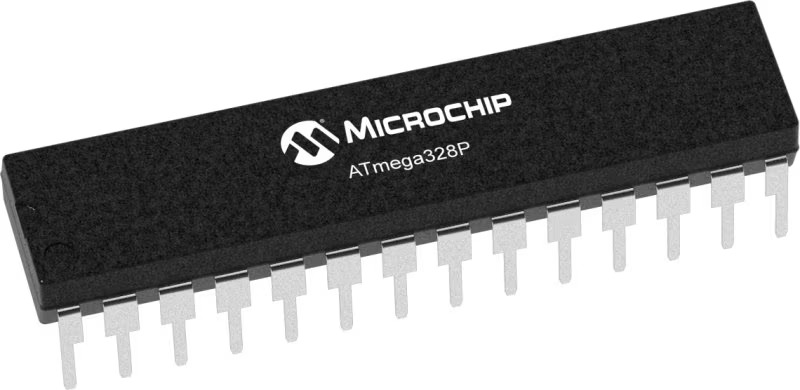
Architecture
AVR
MCU Memory (KB)
32
Silicon Vendor
Microchip
Pin count
28
RAM (Bytes)
2048
You complete me!
Accessories
Click Shield for Arduino UNO has two proprietary mikroBUS™ sockets, allowing all the Click board™ devices to be interfaced with the Arduino UNO board without effort. The Arduino Uno, a microcontroller board based on the ATmega328P, provides an affordable and flexible way for users to try out new concepts and build prototypes with the ATmega328P microcontroller from various combinations of performance, power consumption, and features. The Arduino Uno has 14 digital input/output pins (of which six can be used as PWM outputs), six analog inputs, a 16 MHz ceramic resonator (CSTCE16M0V53-R0), a USB connection, a power jack, an ICSP header, and reset button. Most of the ATmega328P microcontroller pins are brought to the IO pins on the left and right edge of the board, which are then connected to two existing mikroBUS™ sockets. This Click Shield also has several switches that perform functions such as selecting the logic levels of analog signals on mikroBUS™ sockets and selecting logic voltage levels of the mikroBUS™ sockets themselves. Besides, the user is offered the possibility of using any Click board™ with the help of existing bidirectional level-shifting voltage translators, regardless of whether the Click board™ operates at a 3.3V or 5V logic voltage level. Once you connect the Arduino UNO board with our Click Shield for Arduino UNO, you can access hundreds of Click boards™, working with 3.3V or 5V logic voltage levels.
DC Gear Motor - 430RPM (3-6V) represents an all-in-one combination of a motor and gearbox, where the addition of gear leads to a reduction of motor speed while increasing the torque output. This gear motor has a spur gearbox, making it a highly reliable solution for applications with lower torque and speed requirements. The most critical parameters for gear motors are speed, torque, and efficiency, which are, in this case, 520RPM with no load and 430RPM at maximum efficiency, alongside a current of 60mA and a torque of 50g.cm. Rated for a 3-6V operational voltage range and clockwise/counterclockwise rotation direction, this motor represents an excellent solution for many functions initially performed by brushed DC motors in robotics, medical equipment, electric door locks, and much more.
Used MCU Pins
mikroBUS™ mapper
Take a closer look
Click board™ Schematic

Step by step
Project assembly
Software Support
Library Description
This library contains API for DC Motor 11 Click driver.
Key functions:
dcmotor11_control- Motor Controldcmotor11_get_fault- Get Faultdcmotor11_get_interrupt_state- Interrupt state on the INT pin
Open Source
Code example
The complete application code and a ready-to-use project are available through the NECTO Studio Package Manager for direct installation in the NECTO Studio. The application code can also be found on the MIKROE GitHub account.
/*!
* \file
* \brief DcMotor11 Click example
*
* # Description
* This application is motor driver with the current limiting and current sensing.
*
* The demo application is composed of two sections :
*
* ## Application Init
* Initialization driver init and sets first motor settings.
*
* ## Application Task
* Waits for valid user input and executes functions based on set of valid commands.
*
*
* \author MikroE Team
*
*/
// ------------------------------------------------------------------- INCLUDES
#include "board.h"
#include "log.h"
#include "dcmotor11.h"
// ------------------------------------------------------------------ VARIABLES
static dcmotor11_t dcmotor11;
static log_t logger;
uint8_t motor_speed;
uint8_t motor_dir;
uint8_t f_motor_state = 1;
// ------------------------------------------------------ APPLICATION FUNCTIONS
void application_init ( void )
{
log_cfg_t log_cfg;
dcmotor11_cfg_t cfg;
/**
* Logger initialization.
* Default baud rate: 115200
* Default log level: LOG_LEVEL_DEBUG
* @note If USB_UART_RX and USB_UART_TX
* are defined as HAL_PIN_NC, you will
* need to define them manually for log to work.
* See @b LOG_MAP_USB_UART macro definition for detailed explanation.
*/
LOG_MAP_USB_UART( log_cfg );
log_init( &logger, &log_cfg );
log_info( &logger, "---- Application Init ----" );
// Click initialization.
dcmotor11_cfg_setup( &cfg );
DCMOTOR11_MAP_MIKROBUS( cfg, MIKROBUS_1 );
dcmotor11_init( &dcmotor11, &cfg );
dcmotor11_get_fault( &dcmotor11 );
// Start settings
motor_dir = DCMOTOR11_DIRECTION_FORWARD;
motor_speed = DCMOTOR11_VSET_480mV;
dcmotor11_control( &dcmotor11, DCMOTOR11_DIRECTION_FORWARD, motor_speed );
}
void application_task ( void )
{
// Speed increase
motor_speed += 4;
if ( motor_speed >= DCMOTOR11_VSET_4820mV )
{
log_printf( &logger, "---- MAX SPEED ---- \r\n" );
motor_speed = DCMOTOR11_VSET_4820mV;
dcmotor11_control( &dcmotor11, motor_dir, motor_speed );
}
else
{
log_printf( &logger, "---- Speed increase ---- \r\n" );
log_printf( &logger, " MOTOR SPEED: %d \r\n", motor_speed );
dcmotor11_control( &dcmotor11, motor_dir, motor_speed );
}
Delay_ms ( 1000 );
Delay_ms ( 1000 );
// Speed decrease
motor_speed -= 4;
if ( motor_speed < DCMOTOR11_VSET_480mV )
{
log_printf( &logger, "---- MIN SPEED ---- \r\n" );
motor_speed = DCMOTOR11_VSET_480mV;
}
else
{
log_printf( &logger, "---- Speed decrease ---- \r\n");
log_printf( &logger, " MOTOR SPEED: %d \r\n", motor_speed );
dcmotor11_control( &dcmotor11, motor_dir, motor_speed );
}
Delay_ms ( 1000 );
Delay_ms ( 1000 );
// Stop / Start
if( f_motor_state == 1 )
{
log_printf( &logger,"---- Stop Motor!!! ---- \r\n" );
f_motor_state = 0;
dcmotor11_stop( &dcmotor11 );
}
else
{
log_printf( &logger,"---- Start Motor ---- \r\n" );
f_motor_state = 1;
motor_speed = DCMOTOR11_VSET_480mV;
dcmotor11_control( &dcmotor11, motor_dir, motor_speed );
}
Delay_ms ( 1000 );
Delay_ms ( 1000 );
// Direction - Forward / Backword
if ( motor_dir == 2 )
{
log_printf( &logger,"---- Direction - [FORWARD] ---- \r\n" );
motor_dir = 1;
dcmotor11_control( &dcmotor11, motor_dir, motor_speed );
}
else
{
log_printf( &logger,"---- Direction - [BACKWARD] ---- \r\n" );
motor_dir = 2;
dcmotor11_control( &dcmotor11, motor_dir, motor_speed );
}
}
int main ( void )
{
/* Do not remove this line or clock might not be set correctly. */
#ifdef PREINIT_SUPPORTED
preinit();
#endif
application_init( );
for ( ; ; )
{
application_task( );
}
return 0;
}
// ------------------------------------------------------------------------ END
Additional Support
Resources
Category:Brushed





















